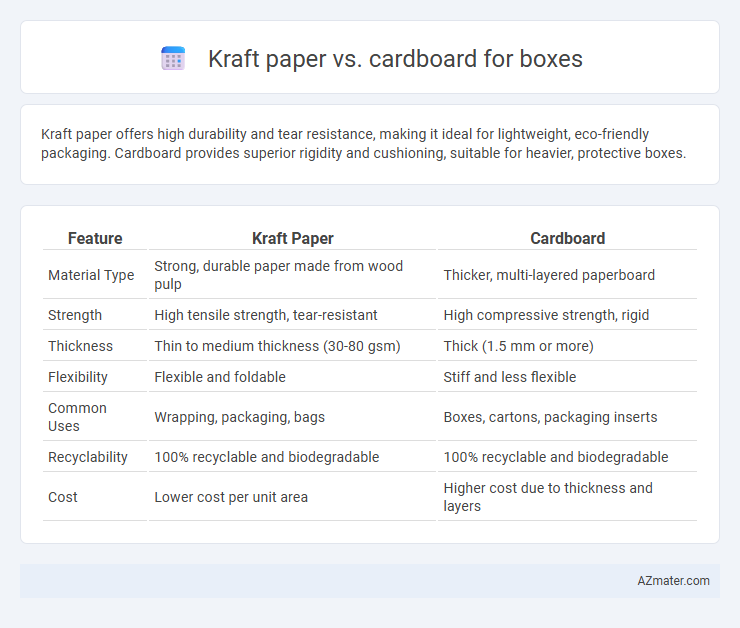Kraft paper offers high durability and tear resistance, making it ideal for lightweight, eco-friendly packaging. Cardboard provides superior rigidity and cushioning, suitable for heavier, protective boxes.
Table of Comparison
| Feature | Kraft Paper | Cardboard |
|---|---|---|
| Material Type | Strong, durable paper made from wood pulp | Thicker, multi-layered paperboard |
| Strength | High tensile strength, tear-resistant | High compressive strength, rigid |
| Thickness | Thin to medium thickness (30-80 gsm) | Thick (1.5 mm or more) |
| Flexibility | Flexible and foldable | Stiff and less flexible |
| Common Uses | Wrapping, packaging, bags | Boxes, cartons, packaging inserts |
| Recyclability | 100% recyclable and biodegradable | 100% recyclable and biodegradable |
| Cost | Lower cost per unit area | Higher cost due to thickness and layers |
Introduction to Kraft Paper and Cardboard
Kraft paper is a durable, high-strength paper made from wood pulp through the kraft process, known for its natural brown color and superior tear resistance, making it ideal for packaging applications. Cardboard, often composed of multiple layers of paperboard including corrugated fiberboard, provides rigid structural support and cushioning, commonly used for shipping boxes and cartons. Both materials offer eco-friendly options, with kraft paper emphasizing recyclability and biodegradability, while cardboard delivers enhanced protection for heavier or fragile items.
Composition and Material Differences
Kraft paper is made from wood pulp processed using the kraft process, resulting in strong, durable fibers ideal for flexible packaging and paper products. Cardboard typically consists of multiple layers of paper pulp glued together, often with a corrugated middle layer, offering rigidity and structural support for boxes. The primary material difference lies in kraft paper's unbleached, high-fiber content versus cardboard's multi-layered composition designed for enhanced strength and cushioning in shipping applications.
Strength and Durability Comparison
Kraft paper offers high tear resistance and flexibility, making it ideal for lightweight packaging with moderate strength requirements. Cardboard, especially corrugated varieties, provides superior strength and durability due to its multi-layered structure, ensuring better protection for heavy or fragile items. For applications demanding maximum load-bearing capacity and impact resistance, cardboard outperforms kraft paper significantly.
Weight and Thickness Considerations
Kraft paper is lighter and thinner compared to cardboard, making it ideal for packaging that requires flexibility and minimal weight. Cardboard, being thicker and heavier, offers enhanced durability and strength to protect heavier or bulkier items during shipping. Weight and thickness considerations are crucial when selecting between kraft paper and cardboard to balance packaging protection with shipping costs.
Environmental Impact and Sustainability
Kraft paper and cardboard differ significantly in environmental impact and sustainability, with kraft paper being more eco-friendly due to its unbleached, biodegradable nature and lower processing requirements. Cardboard, although recyclable, often involves higher energy consumption and chemical treatments that can increase its carbon footprint. Choosing kraft paper for boxes supports reduced waste and promotes sustainable packaging practices by using renewable resources and enabling easier recycling.
Cost Analysis: Kraft Paper vs Cardboard
Kraft paper typically offers a lower-cost option compared to cardboard due to its simpler manufacturing process and lighter weight, making it ideal for budget-conscious packaging solutions. Cardboard, while more expensive, provides enhanced durability and structural strength, justifying the higher expense for heavier or more fragile goods. A detailed cost analysis reveals that choosing kraft paper reduces material and shipping costs, whereas cardboard incurs higher costs but adds value through superior protection and reusability.
Printing and Customization Options
Kraft paper offers a natural, rustic texture ideal for eco-friendly printing techniques like soy-based inks, providing vibrant, organic designs suitable for small-scale customization. Cardboard provides a smoother surface that supports high-resolution, full-color digital printing, enabling detailed graphics and complex branding elements for mass production. Customization options on cardboard extend to various finishes such as gloss, matte, and lamination, enhancing durability and visual appeal in packaging applications.
Applications in Packaging Industry
Kraft paper excels in flexible packaging applications due to its strength, tear resistance, and eco-friendly properties, commonly used for wrapping, bags, and cushioning materials. Cardboard offers superior rigidity and structural support, making it ideal for shipping boxes, product displays, and heavy-duty packaging requiring durability. Both materials are integral to the packaging industry, with kraft paper favored for lightweight protection and cardboard preferred for secure, stackable packaging solutions.
Pros and Cons of Kraft Paper Boxes
Kraft paper boxes offer exceptional strength and flexibility, making them ideal for packaging lightweight to moderately heavy items while being eco-friendly due to their biodegradable nature. They provide excellent printability for branding purposes but may lack the rigidity and durability of cardboard boxes, which can better protect fragile or heavy goods during transport. Cost-efficiency and recyclability are key advantages of kraft paper boxes, although they might not withstand moisture or heavy stacking as effectively as corrugated cardboard.
Pros and Cons of Cardboard Boxes
Cardboard boxes offer excellent durability and structural strength, making them ideal for shipping heavy or bulky items while providing cost-effective protection. Their versatility and recyclability contribute to sustainability efforts, but they are susceptible to moisture damage and can deform under prolonged exposure to water. Compared to Kraft paper, cardboard boxes provide better stacking capability and cushioning but may have higher production costs and less flexibility in design customization.

Infographic: Kraft paper vs Cardboard for Box
 azmater.com
azmater.com